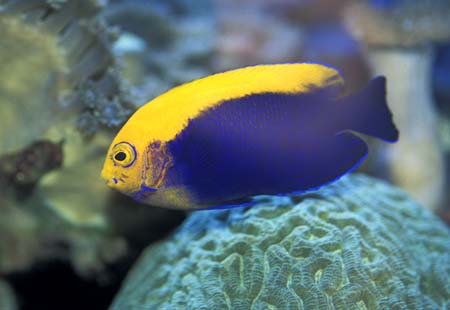Angelfish - Flameback
African Flame Back Angelfish, Yellow Back Angel Fish, Yellowback Angel Scientific Name: Centropyge acanthops
Mon, 28th April, 2025 - 9:28 am GMT
Sponsor Ads:

Alternative Name
African Flame Back Angelfish, Yellow Back Angel Fish, Yellowback Angel Scientific Name: Centropyge acanthopsBasic Info
At maturity, Flameback Angels may reach about three inches (7.5 centimeters) in length. They are deep blue to bluish-purple in color and have bright yellow to orange shading along their backs, from whence their names arise. This coloring extends from the top of the head down the back toward the tail.
Health
A Flameback Angel is best kept in a reef environment, so long as they are not nipping at other inhabitants of the aquarium. Conditions would remain in the mid to upper 70 degrees Fahrenheit (23 to 26 degrees Celsius) with a pH value of 8.3 or 8.4. The specific gravity should remain between 1.020 and 1.025 if the fish is kept alone, and normally the lower end of this range would aid in keeping parasitic infection at bay. If it is kept with invertebrates, specific gravity should remain between 1.023 and 1.025. Flameback Angels should have a variety of foods in their diets to ensure they are receiving proper nutrition. Many will accept live mysis shrimp, brine shrimp, lettuce, plankton, vegetable-based foods, or food formulated for Angelfish. Most Flameback Angels graze on algae in their enclosures. When introducing a Flameback Angel to your aquarium, it is important to choose a healthy fish that is eating in the supplier's aquarium. When introducing a Flameback Angel into an established aquarium, you could rearrange the landscaping to render all fish in the enclosure without a territory. Keep the lights in the aquarium off for a day and monitor the fish as closely as possible.Habitat
Saltwater fishBehavior
Flameback Angels are a small angel that makes a beautiful, colorful resident in saltwater aquariums. These Angels are adored by the people who keep them. The Flameback Angel often brightens up an aquarium with its activity and coloration. However, it may be kept most easily singly. Flameback Angelfish can be aggressive toward fish that they perceive as threats to their territories. Often, fish of similar species, size, or temperament are not accepted. To remedy this, a larger tank would be ideal, in order to allow each fish its own sizeable territory. Flameback Angels have also been reported to nip at coral polyps, which could be a problem in reef tanks, so they must be observed when placed in such situations. They are generally considered to be reef safe and are reported to show the less destructive behavior than most dwarf angels. If you must keep a dwarf angel in a reef environment, it is often recommended that you choose a Flameback Angel. Flameback Angels usually do best in established aquariums containing live rock, which they will often pick through in order to supplement their diets with small organisms.Origin
AfricaHistory
Flameback Angels are found along the western coast of Africa, and are commonly collected from the Kenyan coast. They are also known as African Flameback Angel Fish, probably for their origin.Common Foods
Variety of foods in their diets to ensure they are receiving proper nutrition. Many will accept live mysis shrimp, brine shrimp, lettuce, plankton, vegetable-based foods, or food formulated for Angelfish.Sponsor Ads:
Thoughts on Programming, Number 2: Some years ago, when COBOL was the great white programming hope, one heard much talk of the possibility of executives being able to read programs ... nobody can seriously have this! ... even programmers do not read programs. -The Psychology of Computer Programming, Gerald M. Weinberg
Angelfish - Flameback
Coded by: BGID® | ALL RIGHTS RESERVED Copyright © 2000-2025
Disclaimer | Privacy | Report Errors / Contact | Credits








 President of the United States of America - Real Estate mogul, Pageant owner and now one of the most controversial men in political history.
President of the United States of America - Real Estate mogul, Pageant owner and now one of the most controversial men in political history.  Politician, US Vice President and President of the USA - Joseph Robinette Biden Jr.
Politician, US Vice President and President of the USA - Joseph Robinette Biden Jr.  versus
versus  Russia: 'The Evil Empire'? Are they all that bad or is it just the USA trying to portray Russia as bad because they are a world power with land bigger and a society very different from the USA ideal?
Russia: 'The Evil Empire'? Are they all that bad or is it just the USA trying to portray Russia as bad because they are a world power with land bigger and a society very different from the USA ideal?  Global warming has been in and out as the "latest" hot topic for many years. It is, according to modern scientists, the result of man-made industrial pollutants, clearing forested areas, agriculture, etc. But now they are thinking it started way before the Industrial Revolution...
Global warming has been in and out as the "latest" hot topic for many years. It is, according to modern scientists, the result of man-made industrial pollutants, clearing forested areas, agriculture, etc. But now they are thinking it started way before the Industrial Revolution... 
 Corona virus
Corona virus 
 Users with wide screen monitors can benefit from more content on every page.
Users with wide screen monitors can benefit from more content on every page.